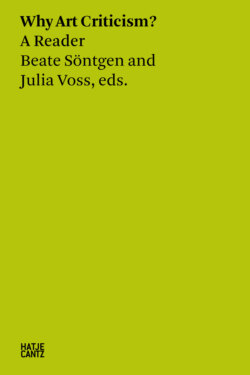Читать книгу Why Art Criticism? A Reader - Группа авторов - Страница 24
ОглавлениеAlexander Rodchenko
Alexander Rodchenko’s 1928 essay “Against the Synthetic Portrait, For the Snapshot” was intended to offer a theoretical classification of his work while also repositioning it politically. In just four years as a photographer, Rodchenko had developed a visual language still considered genuinely avant-garde today: close-ups, surprising perspectives, extreme cropping, and abstracting montages appeared in exhibitions and magazines, on posters, and as book illustrations. In expanding into everyday space, Rodchenko’s photographs were already characterized by the aesthetics of the new, revolutionized society of the nineteen-twenties. At the same time, they stood for his radical concept of art, in which artists in the aftermath of the October Revolution were regarded as role models for the entire Russian population: freed from decorative art, artists were obliged to depart from their traditional view of reality and instead learn to see in a new way. The goal was not something like a mere critique of obsolete art, but rather biopolitics—through aesthetic change, people themselves would be able to change.
At the height of these developments and at a time when Rodchenko’s aesthetic had been broadly established in Russia, his essay was published, offering a rejection of his own success. It began with an analysis of present conditions: given the abundance of newspapers and articles constantly updating knowledge and the abundance of technologies and sciences whose achievements changed on a daily basis, it would be impossible to formulate any aesthetic that could claim supratemporal validity. Of all things, Rodchenko cited as his example a portrait of Vladimir Lenin that had been the subject of dispute for several years. Documentary forms were opposed to idealized, pseudo-realistic forms, multiperspectivity against iconic veneration, avant-gardists against realists. To resolve these conflicts, Rodchenko made a proposal: establishing an archive containing all representations of Lenin. To make clear “that ... it cannot be a matter of any one single everlasting portrait,” there was a need for “a portfolio of photographs, showing him at work and at leisure, an archive of his books, writing pads, notebooks, shorthand reports, film recordings, gramophone recordings.”
Rodchenko’s text appeared in the magazine Novyi Lef (New Left Front of the Arts), for which he was also image editor. With his photomontages, he sought to develop a method for representing a reality based on facts rather than fictions. Key to this factographic representation was the observer not being separated from the object, with the singular perspective of the author remaining visible.
Rodchenko was advocating for this involved and enlightened approach to reality at a precarious moment: Stalin’s consolidation of power was largely complete, the first five-year plan had been adopted with industrialization as the key state doctrine, and what Stalin later called the year of the “great change” began, focusing on a planned economy after a phase of experimentation. In addition, criticism of Rodchenko’s aesthetics was growing ever louder. His works were vilified as plagiarisms of foreign photographs that caused confusion rather than enlightenment. And even if Rodchenko took part in the disputes, they seemed like shadow battles given the critiques of representation he published around the same time. Ultimately, he was seeking not to position his own aesthetics and rather to use an opposites-subverting archival concept that would allow him to remain active as a photojournalist, even in the face of the unrest around him. He succeeded in this.
With his essay and its genuine political commitment, Rodchenko sought to resolve conflicts over the representation of power. It is thus instructive for the present: first, given the conjuncture of multiperspectivity in both postcolonial studies and exhibition practices; second, with respect to archiving the material world through globally networked databases; and third, on the question of representing facts in the post-truth age.
